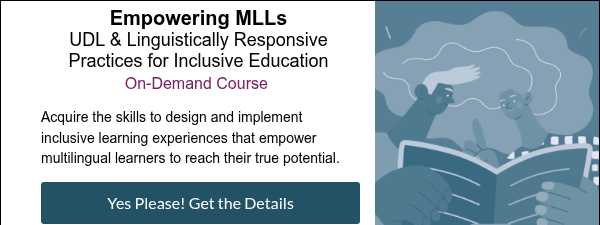Today’s classrooms are enriched by multicultural backgrounds and language diversity. For educators, fostering academic success in language learners may seem daunting and out of our realm of expertise, which is why it is important to recognize and implement Universal Design for Learning (UDL) in all of our classrooms. Using the UDL framework, we can create an equitable environment that fosters academic success for language learners and beyond.
Language learning is a process that can take a long time, sometimes even years, depending on how comfortable the student feels in their learning environment. This can be considered a massive yet predictable barrier to learning. Understanding the language acquisition process is the first step in supporting English learning (EL) students. There are five stages of language acquisition:
1. Silent or receptive,
2. Early production,
3. Speech emergence or production (which can take up to three years),
4. Intermediate fluency,
5. Continued language development
In a traditional classroom, a teacher is likely speaking at the head of the classroom and reviewing printed material on the board or handed out in hard copy. During the initial stages of language acquisition, EL students may feel disengaged, relying on select visuals, facial expressions, and hand movements to grasp the language. If there is an over-reliance on lecturing or printed texts, learners in early language acquisition are excluded from learning.
In a universally designed classroom, students are given opportunities to learn the information in a way that suits their individual learning needs through multiple means of representation. So, instead of one format provided to the entire classroom, such as a printed text in English, students would have multiple options to build understanding. Imagine that instead of assigning a hard copy of the text, everyone is allowed to explore the text digitally or in hard copy. Students accessing the text digitally can listen to the text to support pronunciation and look up key vocabulary. Additionally, teachers can collaborate with students to create multimedia text sets to supplement the anchor text with visuals, illustrations or cartoons, maps, graphs, videos, etc.
This same flexibility can provide multiple means of engagement for EL students (and their classmates, too! Remember, what is necessary for some is good for all!). Instead of one-size-fits-all requirements for students to take a multiple choice test, for example, ensure students can share their understanding in other ways, such as creating videos or designing a visual representation of concepts. You can also increase engagement by encouraging multicultural conversations that allow translanguaging and value all languages in the classroom. [Translanguaging refers to using multiple languages in interaction, often fluidly and adaptively, rather than separating them.] This greatly supports them in increasing engagement and connecting to prior experiences.
Lessons, enriched with a vocabulary-centric and multi-sensory approach, are potent tools for all learners and accelerate learning toward the next stages of mastery and language development. As students progress through the production stages, their choices and autonomy increase, and the development offers more choices for action and expression, where students can demonstrate their learning by leveraging their developing English, including writing and speaking. This stage is the longest, and the time it takes often depends on how comfortable the student feels in their learning environment. Culturally responsive classrooms that recognize students as assets bring rich cultural backgrounds and traditions to the class and use those to foster a sense of belonging. Educators play a vital role in creating and maintaining such environments to increase student success up to the continuous stages where they level up with native speakers.
Tips on how to better support language learners in the classroom:
- Teach with Realia—everyday objects that help learners make connections, such as illustrations, photographs, maps, cartoons, and artifacts.
- Use Mindmaps - Mindmaps help students organize ideas and share their learning. They are a multi-use tool that benefits many (ELs, Dyslexia, etc.) across all subjects, including math. Canva has templates and offers the opportunity to translate.
- Check for Understanding - Offer formative assessment through Visual representation
- Utilize a Cognitive dictionary - It’s a valuable tool for all ages and proficiency levels. It helps learners develop strong vocabulary skills and a deeper understanding of academic content through images, predictions, and meanings. Lynda Williams shares how it works in this video.
- Allow translanguaging and provide key vocabulary. The bilingual brain will make connections in the native language. Therefore, annotations and key vocabulary are first perceived in the student's first language. Once connections are made, students choose vocabulary words to share their learning.
- Integrate Assisted Technology - There are so many assistive technologies out there that can help students develop additional languages. Some of my favorites include:
- Flip Grid—Repetition and practice are necessary for language learners. The flip grid allows recording, editing, and playback to practice oral responses.
- Text to speech - Students can pause and listen to pronunciation.
- Canva - you can easily add graphics and create mindmaps.
Start small. You are likely already using a few tactics within your practice, but when you continue your efforts and continuously implement universal design for learning, you’ll see student outcomes shift. Remember, change takes time. When students feel seen and heard, engagement and persistence increase. You got this!
Continue Your Learning:
- Tips and resources for celebrating student identity
- Leaders, take practical steps toward achieving equity and inclusion. Learn more.
- Advance your career, discover the online course that works best for your learning journey
- The guide to Equity in Education




